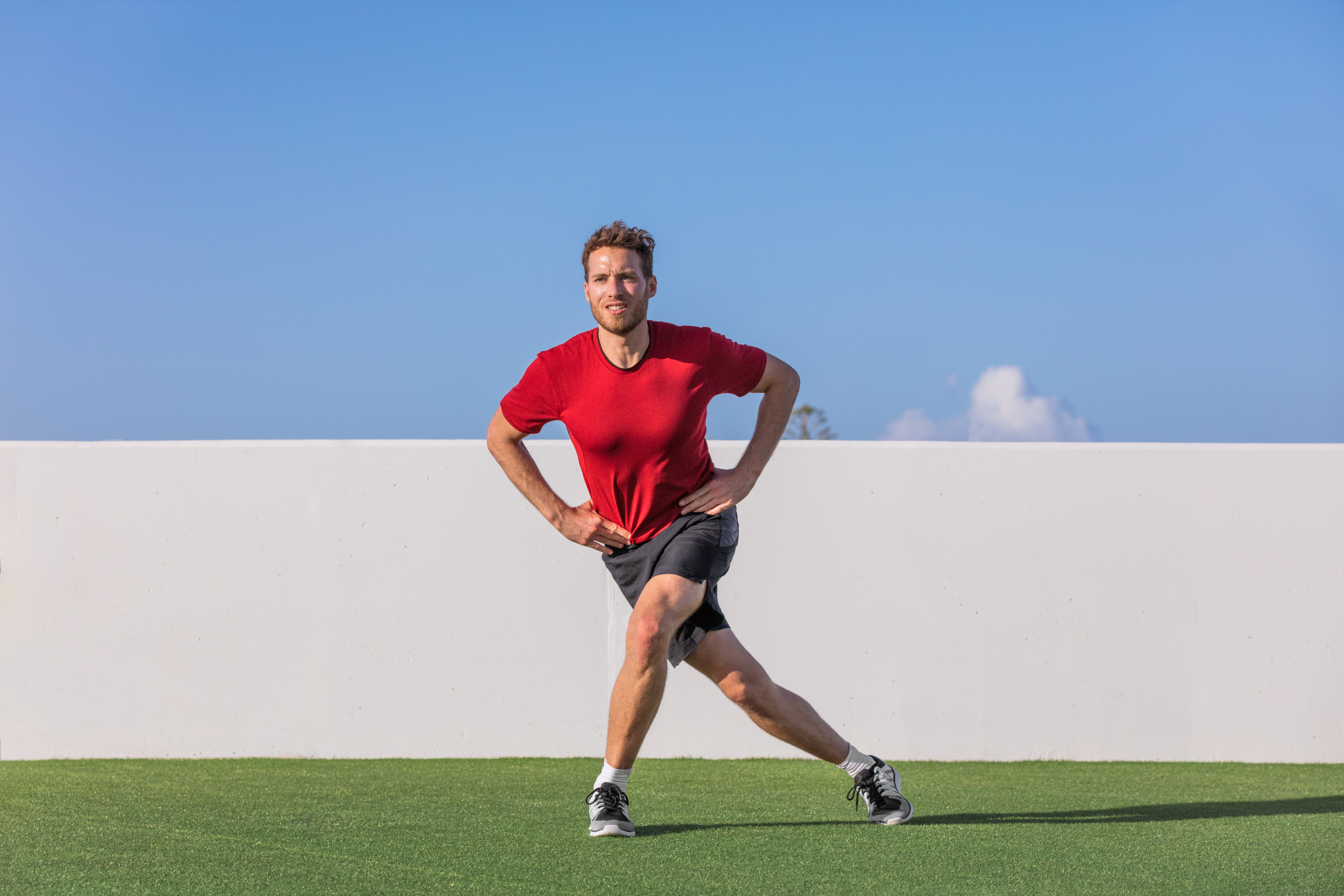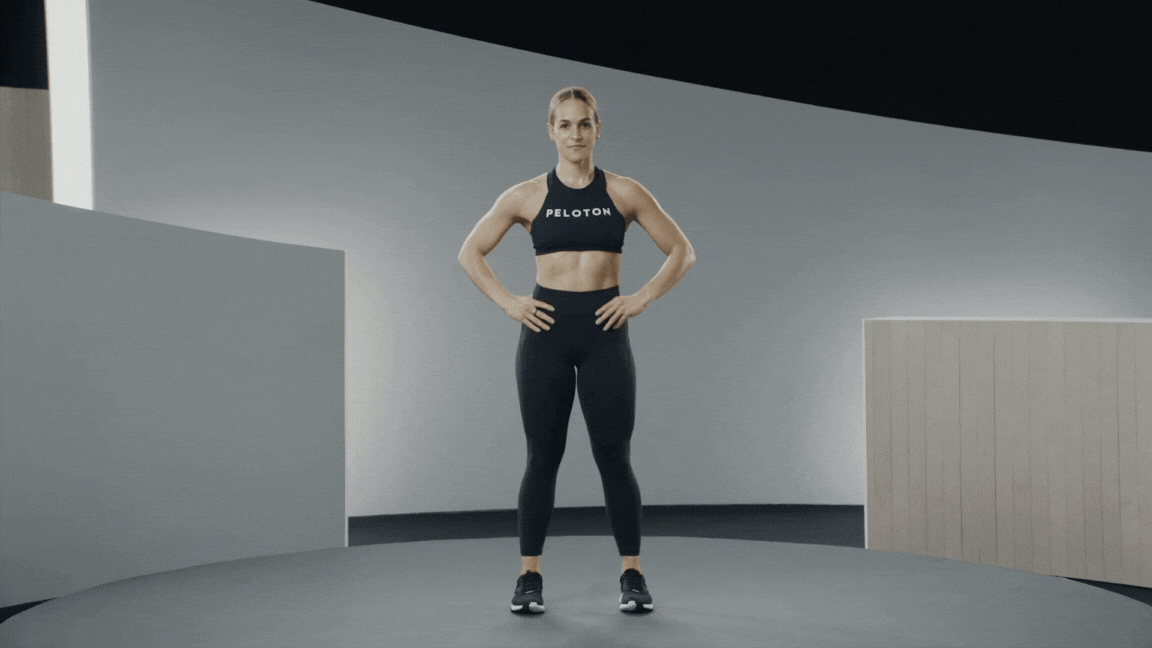
Maridav/iStock/Getty Images Plus via Getty Images
This Lunge Variation Targets the Quads and Glutes. Here's How to Do It
The curtsy lunge (aka curtsy squat) deserves a prime spot in your lower body exercise rotation.
By Alyssa Sparacino•
What Is a Curtsy Lunge?
What Muscles Do Curtsy Squats Work?
The Benefits of Curtsy Squats
How to Do a Curtsy Lunge
Common Mistakes When Doing Curtsy Lunges
Curtsy Squat Modifications and Variations
How to Add Curtsy Lunges to Your Workout Routine
When it comes to banking on a strong backside, there are a lot of great lower body exercises (hi, deadlifts and sumo squats) at your disposal. But there’s one lunge variation that can take the burn up a notch.
Discover more ways to reach your goals with Peloton
The curtsy lunge, which, yes, looks very similar to the Victorian-era plié seen amongst the royal crowd, is a bit of a fitness unicorn in that it targets so many leg muscles simultaneously. Learn more about how this one move efficiently engages your quads, glutes, inner and outer thighs—plus a little core activation, too—as well as how the curtsy lunge is different from other lunge variations.
What Is a Curtsy Lunge?
Think of the curtsy lunge, also referred to as a curtsy squat, as a variation on the reverse lunge, says Peloton instructor Callie Gullickson. With the curtsy lunge your back leg will cross behind your front foot as you bend both knees. It’s a great lower body move that’s quite effective at targeting both the quads at the front of your thighs and your hamstrings and glutes in your posterior chain at the back of the body.
Are Curtsy Lunges Better than Regular Lunges?
A forward lunge or reverse lunge are typically what would be considered a “traditional” or “regular” lunge in that they keep both feet roughly hips-width apart, as if on railroad tracks. Both regular lunges and curtsy strengthen the lower body but each target different muscles in the glutes and legs, says Callie.

What Muscles Do Curtsy Squats Work?
Again, what makes the curtsy lunge unique is that it targets muscles in both the back, front—and even the sides—of your legs. Specifically, your quadriceps, hamstrings, glute medius, glute minimus, adductors, and calves will all light up during this lunge variation, says Callie.
The smaller muscles in the outer glute—that medius and minimus—are targeted when you bend both knees with your back leg crossed behind the front. Your adductors, or inner thighs, are engaged as well as you hold both legs steady toward the midline of the body. This, along with core engagement, helps maintain your balance.

Peloton App
Access thousands of classes with no equipment needed.
Are Curtsy Squats Good for the Glutes?
Curtsy lunges or curtsy squats are a great choice when looking to target your glutes because they expertly activate the smaller glute muscles—your glute minimus and glute medius—that can otherwise be tricky to engage. These accessory muscles might not get as much attention as the glute maximus, the largest of the butt muscles, but they help to stabilize, strengthen, and externally rotate the hip, not to mention create a well-rounded booty.
The Benefits of Curtsy Squats
If you weren’t already sold on why you should be adding the exercise into your leg workouts, take a look at some of the biggest benefits of curtsy squats, according to Callie.
Builds Strength
Lower body workouts not only focus on producing power, which is useful for sports like running or powerlifting, but the curtsy lunge trains both muscular endurance and muscular strength. Opt for bodyweight or light weights and high reps for greater stamina or heavier weights with a lower rep count to pump up the muscle strength and mass.
Improves Balance and Stability
Because your legs are crossed during a curtsy lunge, your balance can be thrown off—especially if you move in and out of this position with each rep. You’ll recruit your core, hip rotators, and inner thighs to stay upright, and training your stability helps prevent falls in everyday life.
Highlights Muscle Imbalances
The curtsy lunge is great for targeting smaller, stabilizer muscles in the hips and thighs in addition to larger muscles like the quadriceps. This helps to find and correct imbalances within muscle groups, but also between sides since the curtsy squat is a unilateral exercise.

How to Do a Curtsy Lunge
Ready to give it a shot? Here’s how to perform the curtsy squat or curtsy lunge with proper form, says Callie.
Cross one leg behind the other. Stand tall and step the right foot back behind the left while keeping hips square. Avoid pivoting right hip backward or stretching right foot too far toward the left.
Bend both knees. With your inner thighs crossed, keep most of your weight in the front left leg, as you bend both knees until the front leg is at a 90-degree angle and the back knee is a few inches from the floor. Hands can be down by your sides or in front of your chest, with or without holding one or two dumbbells.
Return to standing. Push through the front left foot as you exhale a return to an upright position. Return the back right leg to the starting position. Repeat on the same side for a set, or alternate sides with every rep.
Common Mistakes When Doing Curtsy Lunges
Twisting the Hips
There are a few common form mistakes that can happen during the curtsy lunge, including letting your hips twist as you cross one leg behind the other. You want to focus on not over-rotating and maintaining even hips that are square to the front of the room, says Callie.
Improper Knee Alignment
You might also be guilty of letting the knee of the front leg extend outward away from the midline, which can put too much pressure on the knee joint and even put you at risk for injury, particularly if you're using heavy weights. Just as with your hips, you want to keep your knees tracking forward throughout the movement, says Callie.
Not Using Full Range of Motion
Be mindful to use your full range of motion in curtsy squats to reap the biggest benefits of the exercise, she adds. That means bending both knees as outlined in the how-to above. If you’re struggling to maintain this range of motion, consider dropping any weights or reducing the number of total reps.
Curtsy Squat Modifications and Variations
No matter where you are in your fitness journey, there’s a curtsy lunge variation that will work for your body and your goals.
One easy way to modify the curtsy squat is to decrease or eliminate the weight, says Callie. If you’re still working on your balance, you can also keep the back foot planted behind you between every rep rather than needing to shift your weight to return the foot back to the starting position each time.
Keep things interesting by switching up the rep tempo, says Callie. Try bending knees slowly for three counts and climbing back up for three counts, or try it slow on the way down and quick on the way back up. You can also test your mental toughness by holding a curtsy lunge at the bottom for an isolation exercise variation, she says.
Adding weight will increase the difficulty, and you can also vary how you hold one or two dumbbells. Try grabbing one dumbbell goblet style in front of your chest, or holding a single weight on one side for an offset load that will challenge your stability even more, says Callie.
How to Add Curtsy Lunges to Your Workout Routine
Add variety to any lower body workout with curtsy lunges that offer a different skill set and muscle recruitment than, say, a traditional dumbbell front squat or a bodyweight glute bridge.
You can also build a set of curtsy lunges into a HIIT class or full body routine. Bodyweight curtsy lunges can even make for a great on-the-go lower body exercise that you can do anytime, anywhere. The benefits speak for themselves, so you can’t go wrong no matter how you choose to do the curtsy lunge.
This content is for informational and educational purposes only and does not constitute individualized advice. It is not intended to replace professional medical evaluation, diagnosis, or treatment. Seek the advice of your physician for questions you may have regarding your health or a medical condition. If you are having a medical emergency, call your physician or 911 immediately.
Level up your inbox.
Subscribe for a weekly dose of fitness, plus the latest promos, launches, and events.
By providing your email address, you agree to receive marketing communications from Peloton.
For more about how we use your information, see our Privacy Policy.









